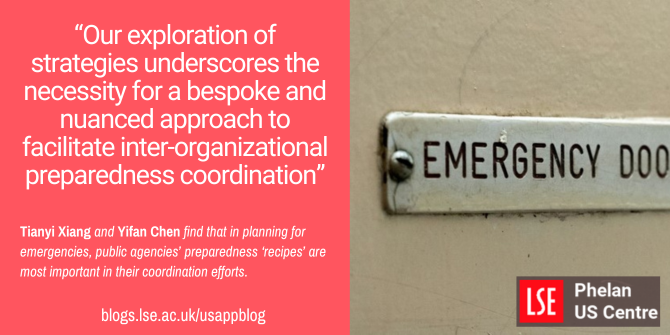
 When disasters or emergencies strike, public agencies must often work together to return communities to normalcy. Tianyi Xiang and Yifan Chen examine why some public agencies coordinate with others in preparation for emergencies and disasters and the combination of factors which drives this active preparedness. Looking at how public transit agencies prepare for extreme weather events, they argue that coordination efforts do not depend solely on individual organizational or environmental attributes, but on how they are arranged. Active preparedness coordination, they write, is likely to occur only when the combinations of organizational attributes fit well with environmental characteristics.
When disasters or emergencies strike, public agencies must often work together to return communities to normalcy. Tianyi Xiang and Yifan Chen examine why some public agencies coordinate with others in preparation for emergencies and disasters and the combination of factors which drives this active preparedness. Looking at how public transit agencies prepare for extreme weather events, they argue that coordination efforts do not depend solely on individual organizational or environmental attributes, but on how they are arranged. Active preparedness coordination, they write, is likely to occur only when the combinations of organizational attributes fit well with environmental characteristics.
The COVID-19 pandemic had a clear lesson: addressing crises that increasingly occur across state and national boundaries requires a collective, unified effort across a spectrum of public agencies. The effectiveness of the response hinges on collaborative efforts made beforehand. Amidst the crisis, the urgency and shared desire to tackle and address challenges can bond different agencies together. However, in the absence of a visible pressing threat, engaging public agencies to jointly prepare for future disasters is often a challenging task. Daily, routine tasks occupy public agencies, leaving them with no extra capacity. Emergency preparedness activities often lack political importance, and struggle to mobilize strong political support. Additionally, emergency managers lack authority to mandate that other agencies should take part in preparedness activities (e.g., pre-planning, joint exercises, and the development of mutual aid agreements).
This raises some important questions: Why do some public agencies actively coordinate with others in preparation for emergencies and disasters? What combination of factors might drive the active preparedness coordination efforts? What strategies can be proposed to facilitate the inter-organizational coordination before an emergency occurs? These are the questions that motivate our new research into what organizational attributes lead to improved coordination of emergency preparedness.
In emergency preparedness, ‘recipes’ matter more than the ‘ingredients’.
Our study delves into the conditions under which public transit agencies are more likely to coordinate with others in preparation for extreme weather events. Conditions here refer to both internal organizational attributes (i.e., organizational capacity, structure, managerial commitment) and external environmental characteristics (e.g., natural, and political environment). We focus on extreme weather events as they are the most common emergency scenarios encountered by public agencies in their daily operations. We study public transit agencies since, like many others, their primary focus is on operations other than emergency management, but they can play a crucial role in emergency response.
We argue that coordination efforts do not depend solely on individual organizational or environmental attributes but on their arrangements or configurations. Coordination activities are organizations’ strategic responses to the changing environment based upon their own properties. Each organizational or environmental attribute is a significant ingredient, but its impact depends on alignment with other attributes.
When we cook, we know that the same ingredients can be combined in different ways to make different dishes. We posit that it is the recipe—the arrangement of conditions—that determines public agencies’ coordination actions. Active preparedness coordination is likely to occur only when the combinations of organizational attributes fit well with environmental characteristics. The results show that recipes matter more than the ingredients, as different organizations, facing distinct organizational properties and environmental constraints, have unique recipes for achieving active preparedness coordination.

Photo by Erik Kroon on Unsplash
Bottom-up and top-down strategies.
Further analysis of recipes for proactive preparedness coordination reveals two distinct strategies: bottom-up and top-down. These strategies depend on different alignments between an organization’s attributes and its external environment.
Bottom-up Strategies: These strategies suggest that organizational decentralization, coupled with employee autonomy, can drive organizations’ preparedness coordination efforts. Our analysis indicates that in the face of environmental stress, large, decentralized public agencies, where employees may not always align with managerial perceptions, are likely to take active coordination efforts. In decentralized organizations, public employees have greater discretion in their daily work and more opportunities to interact directly with the external environment. They are adept at capturing environmental stress and are more likely to internalize the need for greater efforts against extreme weather events in their daily work. Therefore, even when public managers are overwhelmed by their agencies’ primary missions and lack capacity for emergency preparedness work, fostering an organizational culture of innovation and discretion can empower employees. Committed employees can self-organize, engaging external stakeholders to share knowledge, expertise, and resources related to emergency preparation, resulting in frequent and active coordination across organizations.
Top-down Strategies: In contrast to bottom-up strategies, the top-down approach emphasizes that strong managerial commitment, together with employee support, can navigate different organizational and environmental settings and facilitate preparedness coordination. Although environmental stress is typically expected to trigger public agencies’ involvement in emergency preparedness tasks, our analysis reveals that when managers are committed to preparing for extreme weather events and receive sufficient employee support, organizations can take proactive actions regardless of or even in the absence of environmental stimulus. Strengthening managerial commitment is the key to implementing the top-down strategy. There are two ways to boost managerial commitment. First, emergency management professionals can encourage public managers to conduct a comprehensive risk assessment for their organization to increase their risk awareness. Second, communication about how training and exercises can enhance agencies’ capabilities in dealing with threats can also boost managers’ effectiveness in handling potential threats.
Implications for encouraging preparedness coordination.
A few implications stand out when thinking about how to motivate public agencies’ coordination in preparation for emergencies and disasters.
- There is no one-size-fits-all recipe that guarantees proactive coordination engagement. Different organizations can identify their own recipe based upon their organizational and environmental ingredients. The fit among the ingredients is the key.
- Both bottom-up and top-down strategies can lead to active preparedness coordination. The former requires a decentralized structure and greater employee autonomy, while the latter emphasizes the importance of managerial commitment together with employee support.
- Active preparedness coordination might be attributed to employees’ bottom-up initiatives, but its absence is primarily driven by the lack of managerial commitment.
Overall, our exploration of strategies underscores the necessity for a bespoke and nuanced approach to facilitate inter-organizational preparedness coordination. The intricate nature of contemporary emergency and disaster challenges necessitates that public agencies discern and delineate their unique combination of internal dynamics and external factors.
- This article is based on the paper, ‘To coordinate or not? A configurational approach to understand public organizations’ emergency preparedness coordination‘, in Public Administration Review.
- Please read our comments policy before commenting.
- Note: This article gives the views of the author, and not the position of USAPP – American Politics and Policy, nor the London School of Economics.
- Shortened URL for this post: https://bit.ly/3OExZ03






